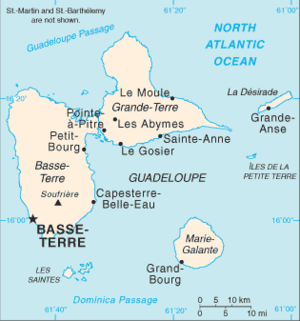- Geography of Guadeloupe
-
 In green (with red legend) are the constituent parts of the Guadeloupe région/département among the Leeward Islands. The 2 islands of Guadeloupe proper are: Basse-Terre Island (left) and Grande-Terre (right).
In green (with red legend) are the constituent parts of the Guadeloupe région/département among the Leeward Islands. The 2 islands of Guadeloupe proper are: Basse-Terre Island (left) and Grande-Terre (right).
The department ofGuadeloupe comprises five islands: Guadeloupe island composed of Basse-Terre Island and Grande-Terre (separated from Basse-Terre by a narrow sea channel called salt river) and the dependences composed by the adjacent french islands of La Désirade, Les Saintes and Marie-Galante. Basse-Terre has a rough volcanic relief whilst Grande-Terre features rolling hills and flat plains. Guadeloupe was formed from multiple volcanoes, of which only Basse-Terre is not extinct.[1]
Further to the north, Saint-Barthélemy and the French part of Saint Martin come under the jurisdiction of Guadeloupe. On December 7, 2003, both of these areas voted to become an overseas territorial collectivity.[2]
Contents
Hurricanes
The island was devastated by several hurricanes in modern times:
- On 12 September, 1928 Okeechobee hurricane caused extensive damage and killed thousands of people.
- On 22 August 1964, Guadeloupe was ravaged by Hurricane Cleo, which killed 14 people.
- Two years later, on 27 September 1966, Hurricane Inez caused extensive damage and killed 27 people, mostly in Grande-Terre. Charles De Gaulle visited the island after the hurricanes and declared it a disaster area.
- On 17 September 1989, Category 4 Hurricane Hugo caused very extensive damage, left more than 35,000 homeless, destroyed 10,000 homes, 100 percent of the banana crops, and 60 percent of the sugar cane crops.
- From late August to mid September 1995, the island was in the path of three successive cyclones: Tropical Storm Iris on 28 August caused minor damages; Hurricane Luis on 5 September caused moderate damages in north coast of Grande-Terre; Hurricane Marilyn on 15 September caused moderate damages in Basse-Terre.
- On 20 September 1998, Hurricane Georges pounded the islands, decimated the banana crops at nearly 100%.
Statistics
- Location
- Caribbean, islands in the eastern Caribbean Sea, southeast of Puerto Rico.
- Geographic coordinates
- 16°15′N 61°35′W / 16.25°N 61.583°W
- Map references
- Central America and the Caribbean
- Area
-
- Total: 1,628 km2 (629 sq mi)
- Land: 1,554 km2 (600 sq mi)
- Water: 74 km2 (29 sq mi)
- Note: Guadeloupe department is composed of six inhabited islands: the main islands which formed Guadeloupe island: Basse-Terre Island on the west and Grande-Terre on the east, and the nearby smaller islands : Marie-Galante, La Desirade, Iles des Saintes (Terre-de-Haut island and Terre-de-Bas island).
- Area – comparative
- 10 times the size of Washington, DC
- Coastline
- 306 km (190 mi)
- Maritime claims
-
- Exclusive economic zone: 200 nmi (370.4 km; 230.2 mi)
- Territorial sea: 12 nmi (22.2 km; 13.8 mi)
- Climate
- Tropical tempered by trade winds; moderately high humidity
- Terrain
- Basse-Terre is volcanic in origin with interior mountains; Grande-Terre is low limestone formation; most of the seven other islands are volcanic in origin
- Elevation extremes
-
- Lowest point: Caribbean Sea 0 m
- Highest point: La Grande Soufrière - 1,467 m (4,813 ft)
- Natural resources
- Cultivable land, beaches and climate that foster tourism
- Land use
-
- Arable land: 14%
- Permanent crops: 4%
- Permanent pastures: 14%
- Forests and woodland: 39%
- Other: 29% (1993 est.)
- Irrigated land
- 30 km2 or 12 sq mi (1993 est.)
- Natural hazards
- Hurricanes (June to October); La Grande Soufrière is an active volcano
- Environment – current issues
- NA
See also
- Communes of the Guadeloupe département
References
 This article incorporates public domain material from websites or documents of the CIA World Factbook.
This article incorporates public domain material from websites or documents of the CIA World Factbook.Sovereign states Antigua and Barbuda · Bahamas · Barbados · Belize · Canada · Costa Rica · Cuba · Dominica · Dominican Republic · El Salvador · Grenada · Guatemala · Haiti · Honduras · Jamaica · Mexico · Nicaragua · Panama · Saint Kitts and Nevis · Saint Lucia · Saint Vincent and the Grenadines · Trinidad and Tobago · United States
Dependencies and
other territoriesAnguilla · Aruba · Bermuda · Bonaire · British Virgin Islands · Cayman Islands · Curaçao · Greenland · Guadeloupe · Martinique · Montserrat · Navassa Island · Puerto Rico · Saint Barthélemy · Saint Martin · Saint Pierre and Miquelon · Saba · Sint Eustatius · Sint Maarten · Turks and Caicos Islands · United States Virgin Islands
Climate of North America Sovereign states Antigua and Barbuda · Bahamas · Barbados · Belize · Canada · Costa Rica · Cuba · Dominica · Dominican Republic · El Salvador · Grenada · Guatemala · Haiti · Honduras · Jamaica · Mexico · Nicaragua · Panama · Saint Kitts and Nevis · Saint Lucia · Saint Vincent and the Grenadines · Trinidad and Tobago · United States
Dependencies and
other territoriesAnguilla · Aruba · Bermuda · Bonaire · British Virgin Islands · Cayman Islands · Curaçao · Greenland · Guadeloupe · Martinique · Montserrat · Puerto Rico · Saint Barthélemy · Saint Martin · Saint Pierre and Miquelon · Saba · Sint Eustatius · Sint Maarten · Turks and Caicos Islands · United States Virgin Islands
Categories:
Wikimedia Foundation. 2010.



